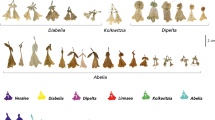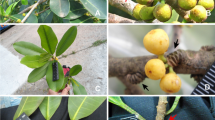Abstract
Machaerium sect. Lineata, with around 30 species of trees, shrubs and lianas, occurs from southern Mexico to northern Argentina and is characterized by the presence of spinescent stipules and leaflets with cladodromous venation. The difficulty of distinguishing species in this section is compounded by a proliferation of taxonomic names. The taxonomy, morphology, and geographic distribution of Machaerium hirtum and four allied species of section Lineata were investigated. The results include the circumscription of the M. hirtum alliance to include M. aculeatum, M. eriocarpum, M. hirtum, M. isadelphum, and M. sericiflorum, as well as two basionyms and 26 synonyms (of which 11 are listed here for the first time), and the designation of the neotype of M. sericiflorum, the lectotypes of M. angustifolium, M. angustifolium var. β, M. angustifolium fo. glauca and M. armatum, and the epitype of M. hirtum. In addition to the wide variation and overlap of certain morphological characters, the problems in the circumscription of this complex may also be related to their broad distribution range, which corresponds to that known for the genus as a whole. Vegetative and reproductive characters were used to delimit the five species. Among the important characters are the dimensions and indumentum of the leaflets, bracteoles, calyx, and banner petal, and the presence of diadelphous stamens. Machaerium isadelphum and M. hirtum have the largest geographic range, while M. eriocarpum is restricted to southwestern South America and M. aculeatum and M. sericiflorum are endemic to Brazil. Identification keys, descriptions, illustrations, geographic distributions, and habitat are used to distinguish the species.
Resumo
Machaerium sect. Lineata compreende cerca de 30 espécies de árvores, arbustos e lianas, presentes do sul do México até a Argentina e se caracteriza pela presença de estípulas espinescentes e folíolos de venação cladódroma. A dificuldade para a distinção entre as espécies da seção ocasionou muitas divergências nomenclaturais. A taxonomia, morfologia e distribuição geográfica de M. hirtum e quatro espécies afins da seção Lineata foi investigada. Os resultados incluíram a circunscrição do complexo taxonômico M. hirtum, composto por M. aculeatum, M. eriocarpum, M. hirtum, M. isadelphum e M. sericiflorum, bem como dois basiônimos e 26 sinônimos (11 citados aqui pela primeira vez), a designação do neótipo de M. sericiflorum, dos lectótipos de M. angustifolium, M. angustifolium var. β, M. angustifolium fo. glauca e M. armatum e do epítipo de M. hirtum. Além da ampla variação e sobreposição de certos caracteres morfológicos, os problemas na circunscrição deste complexo também estão relacionados à sua amplitude de distribuição, correspondente ao esperado para o gênero como um todo. Foram reconhecidos caracteres vegetativos e reprodutivos consistentes para a delimitação das cinco espécies e, dentre eles, as dimensões e indumento dos folíolos, bractéolas, cálice, vexilo e a adelfia do androceu foram os mais distintivos. Dentre as espécies, M. isadelphum e M. hirtum apresentam a maior abrangência geográfica, enquanto M. eriocarpum é restrita ao sudoeste da América do Sul e M. aculeatum e M. sericiflorum são endêmicas do Brasil. Chave para a identificação das espécies, descrições, ilustrações, distribuição geográfica e habitat são apresentados.





Similar content being viewed by others
Literature Cited
Amshoff, G. J. H. 1939. On South American Papilionaceae. Mededeelingen van het Botanisch Museum en Herbarium van der Rijks-universiteit te Utreecht 52: 1–78.
Bentham, G. 1837. Commentationes de Leguminosarum Generibus. Wien IV: 1–78.
———. 1860. A synopsis of the Dalbergieae, a tribe of Leguminosae. Journal of the Proceedings of the Linnean Society 4: 1–134.
———. 1862. Papilionaceae. Pp. 232–259. In: C. F. P. Martius (ed.). Flora Brasiliensis 15 (1): 1–350.
Chodat, R. & E. Hassler. 1904. Plantae Hasslerianae. Bulletin de l’Herbier Boisser 2(4): 892–893.
De Candole, A. G. 1825. Systematis naturalis regni vegetabilis. Prodromus 2: 257–259.
Ducke, A. 1949. Notas sobre a Flora Neotrópica II. As Leguminosas da Amazônia brasileira. Boletim Técnico do Instituto Agronômico do Norte 18: 1–248.
Dwyer, J. D. & F. J. Hermann. 1965. Flora of Panama. Part V, fascicle 4. Family 83. Leguminosae. Subfamily Papilionoideae (in part). Annals of the Missouri Botanical Garden 52(1): 1–54.
Ellis, B., D. C. Daly, L. J. Hickey, K. R. Johnson, J. D. Mitchell, P. Wilf & S. Wing. 2009. Manual of leaf architecture. The New York Botanical Garden Press, Ithaca, NY.
Filardi, F. L. R. 2011. Avanços na Sistemática de Machaerium Pers. (Leguminosae Papilionoideae Dalbergieae): Filogenia e Revisão Taxonômica das espécies do Domínio Atlântico. Ph.D. thesis, Escola Nacional de Botânica Tropical, Instituto de Pesquisas Jardim Botânico do Rio de Janeiro.
Hickey, M. & C. King. 2000. The Cambridge illustrated glossary of botanical terms. University Press, Cambridge.
Hoehne, F. C. 1938. Cincoenta e uma novas espécies da flora do Brasil e outras descrições e ilustrações. Arquivos de Botânica do Estado de São Paulo 1 (1):1–49.
———. 1941. Leguminosas Papilionadas (Machaerium e Paramachaerium). Flora Brasilica 25 (3): 1–99.
Klitgaard, B. B. & M. Lavin. 2005. Dalbergieae. Pp. 307–335. In: G. P. Lewis, B. Schrire, B. Mackinder & M. Lock (eds.). Legumes of the world. Royal Botanic Gardens, Kew.
LAWG - Leaf Architecture Working Group. 1999. Manual of Leaf Architecture - morphological description and categorization of dicotyledonous and net-veined monocotyledonous angiosperms. Smithsonian Institution, Washington.
Lima, H. C. 1995. Leguminosas da Flora Fluminensis - J. M. da C. Vellozo - Lista atualizada das espécies arbóreas. Acta Botanica Brasilica 9 (1): 123–146.
Lozano, P. & B. B. Klitgaard. 2006. The genus Machaerium (Leguminosae: Papilionoideae: Dalbergieae) in Equador. Brittonia 58 (2): 124–150.
Macbride, J. F. 1943. Flora of Peru - Family Leguminosae. Botanical Series Field Museum of Natural History 3 (1): 1–507.
Radford, A. E, W. C. Dickison, J. R. Massey & C. R. Bell. 1974. Vascular plant systematics. New York. Harper & Row.
Rudd, V. E. 1977. The genus Machaerium (Leguminosae) in Mexico. Boletin de la Sociedad Botanica de Mexico 37: 119–146.
———. 1987. Studies in Machaerium (Leguminosae) VII: Section II. Lineata. Part I: Species with wingless fruit. Phytologia 64 (1): 1–12.
Stellfeld, C. 1944. Nomes vulgares das plantas estudadas por Frei Vellozo em sua Flora Fluminensis. V. Tribuna Farmacológica 12 (7): 127–136.
Taubert, P. 1894. Machaerium. Die Naturlichen Pflanzenfamilien 3 (3): 336–337.
Vellozo, J. M. da C. 1829 (1827). Florae Fluminensis Icones. Paris 11 vol. 1640.
Vogel, T. 1837. Dalbergiearum genera brasiliensis. Linnaea 11: 177–195.
Acknowledgments
The authors express their gratitude to curators of the herbaria that were visited; to Aline Oliveira and Maria Alice Rezende for the illustrations and to Erika von Sohsten Medeiros for high resolution figures; to Dra. Cláudia Franca Barros (Rio de Janeiro Botanic Gardens) and to Dra. Marli Pires Morim (Rio de Janeiro Botanic Gardens) by the orientation and valuable suggestions towards improving of the first author’s Ph.D. thesis. We also acknowledge two reviewers for their useful suggestions, and the first author extends her thanks to Brazilian Research Council (CNPq) for the Doctoral grant and also to IAPT for financial resources provided.
Author information
Authors and Affiliations
Corresponding author
Rights and permissions
About this article
Cite this article
Filardi, F.L.R., De Lima, H.C., Klitgaard, B.B. et al. Taxonomy and nomenclature of the neotropical Machaerium hirtum complex (Leguminosae, Papilionoideae). Brittonia 65, 154–170 (2013). https://doi.org/10.1007/s12228-012-9276-7
Published:
Issue Date:
DOI: https://doi.org/10.1007/s12228-012-9276-7




